Amarok/QuickStartGuide/TheMusicCollection/fr: Difference between revisions
Created page with "Si vous n'avez pas de fichiers musicaux sur votre ordinateur, il est facile de les ''extraire'' (copier les pistes de vos CD vers votre collection). Insérez un CD, faites un..." |
Created page with "250px|thumb|center" |
||
| Line 41: | Line 41: | ||
[[Image: | [[Image:Amarokripcd_FR.png|250px|thumb|center]] | ||
Revision as of 00:31, 21 January 2014
La Collection Musicale
Le panneau des sources de média
Le panneau Sources des média est l'endroit où vous pouvez afficher et naviguer à travers votre collection musicale complète. Ceci inclut les chansons se trouvant sur votre disque dur local aussi bien que celles se trouvant sur des supports externes branchées à votre ordinateur comme des CDs audio, des appareils USB, des lecteurs de media, des disques réseau ou des sources provenant d'internet.
Configurer une collection
Possédez-vous des pistes musicales au format mp3, Ogg ou FLAC sur votre ordinateur ? Commencez par indiquer à Amarok où trouver ces fichiers, ainsi il peut créer votre collection. Dans le menu:
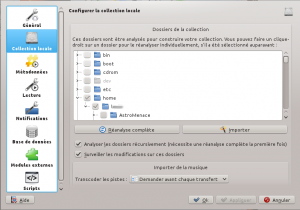
Une vue arborescente de votre dossier personnel est affichée comme ci-
dessus. Cochez les cases où votre musique est enregistrée ; habituellement dans . Ensuite choisissez . Cela
prendra un peu de temps, donc ne vous inquiétez pas si Amarok semble lent pendant un moment. Une fois l'analyse achevée, il est préférable de quitter Amarok en utilisant le menu en haut, ou Ctrl + Q, puis de le redémarrer. Votre musique
nouvellement ajoutée devrait s'afficher dans la section Collection Locale.
Apprenez-en plus
ici.
Ajouter des périphériques de média à la collection
Sous la barre de recherche près du haut du panneau Sources de Media sont affichés les différents périphériques et / ou les catégories de contenu du Navigateur de contenu. Si vous insérez un CD audio dans le lecteur de CD, il apparaîtra dans le panneau Sources de Media aux côtés des lecteurs multimédia, clés USB et d'autres périphériques USB. Lorsque un périphérique externe est monté, il est automatiquement affiché dans le panneau des Sources de Media.
La capture ci-dessous affiche trois sources connectées contenant de la musique : un CD audio, un lecteur mp3 et la Collection Locale.
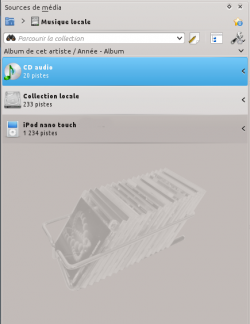
Extraire un CD vers la collection
Si vous n'avez pas de fichiers musicaux sur votre ordinateur, il est facile de les extraire (copier les pistes de vos CD vers votre collection). Insérez un CD, faites un clic droit sur la bannière du lecteur de CD dans le Navigateur de Contenu pour lire, ou copier vers votre collection, ce qui extraira et balisera vos pistes (cf l'image ci-dessous). Si vous copiez de la musique depuis un CD audio vers votre Collection Locale, la Barre de messages au bas de la fenêtre Amarok indiquera qu'il est occupé à copier la musique. L'extraction peut durer plusieurs minutes. Une fois l'extraction achevée, le message dans la barre de messages disparaît et la musique apparaît dans le navigateur de contenu de votre Collection Locale. Si la musique extraite n'apparaît pas dans le panneau des Sources de Media, vous devez alors quitter Amarok depuis le menu tout en haut, ou appuyer sur les touches Ctrl + Q et redémarrer. À présent vous devriez voir la musique extraite dans votre collection. La capture d'écran ci-dessous montre comment déplacer les pistes d'un CD audio, d'un iPod ou d'un autre périphérique vers votre collection, en utilisant le menu contextuel (avec un clic droit).
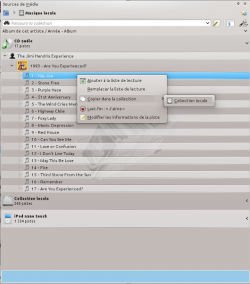
In the above context menu, you can also see the choice to . Use this option if you have a track that needs a tag edited. This becomes important when you rip music to .WAV format, losing some of the tags. If quite a bit of your collection needs tagging, consider dedicated tagging software, such as
Correct tagging is important to help Amarok show your tracks in the appropriate albums and proper sort order. Learn more about ripping and tagging.
Accessing other media sources
You might have wondered why the Media Sources pane is not called the 'Collections' pane. Amarok gives you access to much more music than just your collection -- Internet shops, audio books, podcasts, music files stored outside your collection, and previously stored playlists. The Amarok breadcrumb navigation is the key to all of this. The starting icon for the breadcrumb navigation is the home folder icon at the extreme top left of the Media Sources pane. This icon expands and contracts as you browse through the Media Sources pane, allowing you to easily navigate your collection by clicking your desired folder in the breadcrumb bar.

If you click the Amarok home folder you see the Media Sources pane on the left below, containing icons to available resources. If you click (left image below, second item from the bottom), you will see something similar to the image on the right, below. Notice how the breadcrumb bar expands and how the content of the selected folder is shown in the Media Sources pane (right image below). Clicking the > symbols among the breadcrumbs allows you to view the folders available at that level of the folder structure. The Amarok file browser gives you access to your entire file system, even outside your Local Collection.
| Media Sources pane | Files icon clicked |
|---|---|
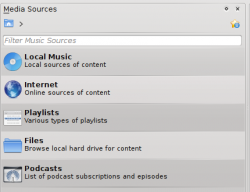 |
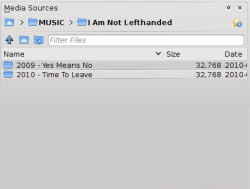 |
The functions of the icons in the Amarok Home folder (left above) are:
| Icon | Name | Action |
|---|---|---|
| Your Amarok collection | ||
| Internet shops such as Magnatune, Jamendo and Last.fm. First configure your internet resources in: | ||
| Saved playlists -- see also Playlists. Also playlists on media devices | ||
| Your file system | ||
| Access to Podcasts via RSS feed |
Clicking in the root of Media Sources (image above) or in the breadcrumb bar returns you to your collection, showing you a list of all the available resources, artists, albums and tracks that you have previously defined as part of your collection. The breadcrumb bar indicates that you are viewing Local Music.
Streams and Podcasts
There are two ways to listen to streams.
- If you have a favorite station, get the stream URL and add it: . If you then save your playlist, later you can find it again in Playlists, as a Saved Playlist.
- Browse through the scripts available in our Script Manager, up to Amarok 2.4.0, after 2.4.1 . There are some excellent collections available, which will show up in the Internet section of your Media pane.
Podcasts have their own section in the Media pane, above. If you have an RSS or Atom feed URL, click the ![]() and add it there. If you have an OPML file to import, that choice is available also. Use the context (right-click) menus to , , , , or mark an episode as . If you are interested in browsing through a large collection of podcasts, check out the Podcast Directory available through the Script Manager, referred to above.
and add it there. If you have an OPML file to import, that choice is available also. Use the context (right-click) menus to , , , , or mark an episode as . If you are interested in browsing through a large collection of podcasts, check out the Podcast Directory available through the Script Manager, referred to above.
More about configuring Amaroks Internet Services here.
Using the Content Browser
The hard disk of your computer, audio CDs, external devices and the Internet are the basic resources for your collection. After your collection has been set up, it is likely that your collection will hold a large number of albums and tracks, much more than can be shown on a single window.
How to change the display of your collection, below:
Hiding or expanding information
The area of the Media Sources pane below the search bar is called the Content Browser. Three media sources are indicated in the image of a Content Browser below: CD, Local Collection and a Media Player:

Clicking the banner for a device (the blue bar for the Sansa above) shows or hides the content of that device. The direction of the arrow on the right indicates whether the contents for that device is hidden or shown. The content on a particular device can, in turn, be hidden or shown using the same principle, clicking on the appropriate artist or album. An arrow pointing down on the left of an artist or an album indicates that the contents has been expanded. An arrow pointing right indicates that more content for that category is available but currently hidden. In the image above, the information for Mike Oldfield - The Songs of Distant Earth CD has been expanded, showing the individual tracks. On the other hand, the albums and tracks in the Local Collection are hidden. By clicking these arrows you also can expand or hide information.
Changing the order of tracks and albums
The order in which tracks are sorted in the Content Browser can be customised by using the ![]() button at the top of the Media Sources pane:
button at the top of the Media Sources pane:
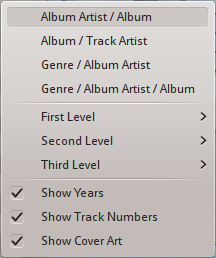
The sort order is indicated on the top left of the Media Sources pane, just below the Search text box. The default order is Artist / Year - Album. The display order of the Content Browser can be temporarily switched between the user-defined sort order (described above) and a Merged view in which artists are listed alphabetically, no matter on which media the music is stored. To toggle the Merged view, click the ![]() icon at the top right-hand of the Media Sources pane:
icon at the top right-hand of the Media Sources pane:
To search your collection, type your search term into the Search bar at the top of the Local Music section. Not only can you search by artist, album or track name, but any part. You might create a nice playlist by searching for winter, for instance, or merely find a track when you only remember one word of the title. You can also search by rating, playcount, even filetype. See Search in Collection for more details.
Deleting items from the collection
You can delete any item from your collection by right-clicking on it and choosing the bottom item . A confirmation dialog will appear, preventing the accidental deletion of any tracks. More than one item can be selected with Ctrl + click.

